Treasury Building, Brisbane
The Treasury Building, also previously known as the New Public Offices, is a heritage-listed former government public administration building located at 21 Queen Street, Brisbane City, City of Brisbane, Queensland, Australia. It was built from 1886 to 1928 for the Queensland Government. On 21 October 1992 the Italian Renaissance[1] style building was added to the Queensland Heritage Register.[2]
| Treasury Building, Brisbane | |
|---|---|
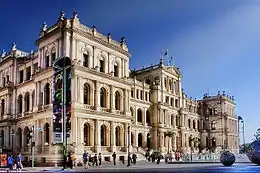 Queen Street facade of the Treasury Building, 2008 | |
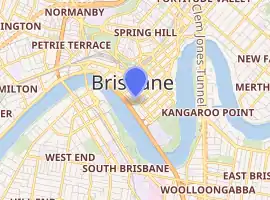
| |
| Alternative names | The Treasury |
| General information | |
| Architectural style | Italian Renaissance[1] |
| Location | Brisbane Square, Brisbane |
| Address | 21 Queen Street (on the block bounded by Queen Street, George Street, Elizabeth Street, and William Street), Brisbane city, Queensland |
| Current tenants | Treasury Casino |
| Inaugurated | 8 April 1930 |
| Owner | Star Entertainment Group |
| Design and construction | |
| Architecture firm | John James Clark |
 Location of Treasury Building, Brisbane in Queensland | |
| Location | 21 Queen Street, Brisbane City, City of Brisbane, Queensland, Australia |
| Coordinates | 27°28′18″S 153°01′25″E |
| Design period | 1870s - 1890s (late 19th century) |
| Built | 1886 - 1928 |
| Official name | Treasury Building, New Public Offices, Treasury Casino |
| Type | State heritage (built) |
| Designated | 21 October 1992 |
| Reference no. | 600143 |
| Significant period | 1880s-1920s (fabric) 1880s-1980s (historical) |
| Significant components | wall/s |
The building is located at North Quay, near the northern end of Victoria Bridge. Although officially fronting on Queen Street, the building occupies an entire city block surrounded by Queen Street, George Street, Elizabeth Street and William Street. The Elizabeth Street frontage is opposite the Queens Gardens. In the 1890s and early 1900s the imposing Treasury Building served as a symbol of self-government and as a focus for celebratory and patriotic displays.
It is currently occupied by the Treasury Casino owned by Star Entertainment Group.
History
The Treasury Building was erected in three stages between 1886 and 1928.[2]
.jpg.webp)
The site at the junction of the George Street and Queen Street had been reserved for government purposes from 1825. It was occupied initially by convict-built officers' quarters and a two-storey military barracks.[3] In 1864 the military moved from the site and the existing buildings were occupied by the Registrar-General, Treasury and Engineer of Harbours. In 1874 a single-storeyed building for the Registrar-General was erected on the corner of George and Queen Streets, anticipating a government re development of what had become known as Treasury Square.[2]
In 1883 the Queensland Government decided to construct new public offices on Treasury Square. A design competition, for a two-storeyed perimeter block to occupy the entire square, was won by Melbourne architects Grainger and D'Ebro, but their design was never used. The newly-appointed Queensland colonial architect, John James Clark, argued that the site warranted a four-storeyed complex, to be erected in stages as government accommodation was required. Clark's own neo-Italianate design, entered in the competition prior to his appointment as Queensland colonial architect in September 1883, was used.[2]
Clark is significant in Australian architectural history. He received his training and experience in the architectural office of the Victorian Department of Public Works, and designed major public buildings in Victoria (e.g. the Old Treasury Building in Melbourne[3]), Queensland and Western Australia.[2]
Documentation for the first stage of the Treasury Building, which fronted William Street and the Brisbane River and returned a short distance down Elizabeth and Queen Streets, was completed by mid-1885, and site preparation followed immediately. Tenders for the main contract were called in April 1886, and Sydney builders Phippard Bros & Co. were successful with a contract price of £94,697/10/-. The principal architect on site was Thomas Pye, who resigned from the colonial architect's office in February 1887 to supervise the construction as a Phippard Bros employee.[2]
When completed in September 1889, the new centre of government administration in Queensland was occupied by the Premier, Colonial Secretary, Registrar-General (in a purpose-built fire-proof section at the corner of William and Elizabeth Streets), Treasury, Mines, Works, Police and Auditor-General. It was home to the Cabinet and frequently to the Executive Council from late 1889 to 1905.[2] In 1905 the Premier's Department moved into the Executive Building (subsequently known as the Lands Administration Building) in George Street.
.jpg.webp)
Stage two, which completed the Elizabeth Street section and continued two-thirds of the way along the George Street frontage, was commenced almost immediately. The documentation and working drawings were prepared by Thomas Pye, re-employed by the colonial architect's office to supervise the project. Tenders were called in April 1890, and the principal contract was let to builder John Jude of Adelaide, with a contract price of £67,000.[2]
The contract was completed by February 1893 and the new wing was occupied in the middle of that year by the Registrar of Titles, Justice, Works, Public Instruction and the State Savings Bank, for whom a purpose-built banking chamber was included in the design which in all other details replicated stage one. Later in 1893 the courtyard was landscaped with a grass oval surrounded by a gravel carriageway, border planting, and trees.[2]
The site then consisted of stages one and two of the Treasury Building, and the 1874 office of the Registrar-General.[2]
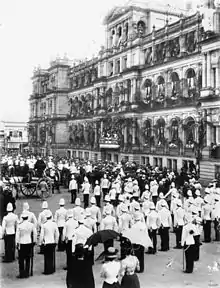
In the 1890s and early 1900s the imposing Treasury Building served as a symbol of self-government and as a focus for celebratory and patriotic displays.[2] In 1901, the proclamation of the Federation of Australia was read by the Governor of Queensland Baron Lamington from a balcony on the William Street elevation.[3][4]
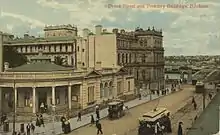
Owing to the construction around the turn of the century of new offices for the Department of Agriculture and the Executive Building (Land Administration Building), which provided additional Queensland Government accommodation, work on the third stage of the Treasury Building was not started until 1922. The Registrar-General's building was demolished late 1922/early 1923, and construction commenced in mid-1923, using day labour. This was deliberate government encouragement of state enterprise, as was the government acquisition of Millers Quarries at Helidon to provide the stone.[2]
The front elevation of the third section differed only slightly from Clark's original concept, although structurally and in internal materials and fittings it was a 1920s building. It was completed, occupied and opened officially in 1928 at a final cost of £137,817, providing expanded accommodation for existing Treasury Building tenants.[2]
In the 1950s, demand for further accommodation led to the construction in 1961 of a five-storeyed annex in the courtyard. In 1971 the Treasury and Works Departments moved to the new Executive Building at 100 George Street, thus severing the Treasury Building's connection with these principal government departments. The annex was demolished in 1987, in anticipation of a major government refurbishment of the site.[2]
Since 1989 the Registrar-General has remained the sole occupant of the Treasury Building, but it continued to be the best known and identifiable government office building in Queensland.[2]
The Treasury Building, along with the Lands Administration Building were sold and now form the Treasury Casino.
Description
The Treasury Building, a four-storeyed masonry perimeter block, occupies an entire city block bounded by Queen, George, Elizabeth and William Streets. It forms the northern edge of the group of important public buildings surrounding Queens Gardens. These include the Lands Administration Building to the southeast of the park, the Family Services Building to the northeast, and on the southwestern edge, between the gardens and the Brisbane River, the Old State Library and the North Quay porphyry wall.[2] Like the Treasury Building, the gardens, neighbouring buildings and wall are all heritage-listed.
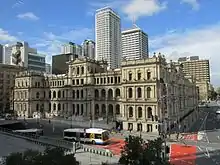
The view of the William Street facade from the river, although interrupted by South-East Freeway, is enhanced by the elevated position of the site. The building consists of a partly sunken basement and an elevated ground floor or piano nobile above which are two additional floors. It is built to the property alignment around a large central courtyard.[2]
The design is consistent with English practice of the late nineteenth century in employing a classical style drawn from sixteenth century Italian architecture. Arcades protect the northeast, northwest and southwest elevations. The arcaded facades are symmetrical with central towers of one additional storey surmounted by a pediment. The corners are emphasised with pavilions which step forward terminating the arcades. The basement walls are distinguished by smooth banded rustication. The southeast facade has no arcade and no central tower.[2]
The building is faced with sandstone ashlar except for the inner walls of the arcade. These brick walls are finished with lined and unpainted render imitating ashlar. Each phase of construction has used a different type of sandstone. A colour difference is discernible between the Highfields stone used for the first phase of construction, and the Helidon sandstones used for the later stages. The external walls sit on a porphyry plinth. A matching porphyry dwarf wall adjoins the building on some elevations surmounted by a wrought iron fence.[2]
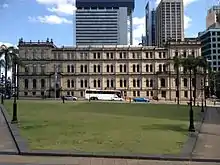
The first and second phases of construction employ a fire protection system in parts of the building. Vaulted coke concrete floors are supported on concrete encased wrought iron joists and bearers. Beams are supported at walls by engaged piers or on freestanding concrete encased cast iron columns. Steel roller shutters slide down to protect openings. The structure of the third phase of the building consists of reinforced concrete slabs supported on loadbearing masonry columns and steel girders. The roofs of the earlier sections are hipped corrugated iron, easily distinguished from the roof of the third stage which is a flat reinforced concrete slab protected by a bituminous membrane.[2]
The building has several entrances. The main entry is located centrally on the Queen Street facade where a wide flight of stairs leading to three sets of timber-framed glass double doors in arched doorways gives access to a foyer on the ground floor level. The foyer has a coffered plaster ceiling and strongly patterned floor. A pair of Ionic columns opposite the entrance frame the central flight of the symmetrically designed grand staircase. This staircase, part of the third phase of construction, is made of reinforced concrete rather than the cast iron stringers with slate treads that were used on the earlier staircases. The staircase is lit with Palladian motif windows opening onto the courtyard.[2]
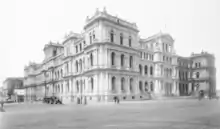
Wide continuous hallways connect all rooms on each level while vertical circulation is via generous staircases located along the hallway. With the exception of the grand staircase, stairwells are top lit by delicate timber framed glass lanterns. All staircases feature timber handrails, ornamental cast iron balustrades and stair landings that are contrasted with the treads by the use of bold geometric patterning. Some of the original staircases have been removed. Rooms open off the hallways on both sides and are lit either from the street or via the courtyard. Cast-iron balconies run around the courtyard on every level. Rooms facing the courtyard have french doors opening onto these balconies. Two wings containing toilets and washrooms project into the courtyard space.[2] The building has restrained rendered and painted interiors that feature cedar joinery and ornamental plasterwork. The level of ornateness varies according to the importance of the room. Rooms in the William Street wing have decorative cast-iron wall ventilators, marble fireplaces and plaster ceiling roses. The Cabinet room, positioned in the centre of this wing on the piano nobile, is distinguished by a more embellished plaster ceiling and elaborate carved cedar panels over the doorways. Ministers' suites, located in the corner pavilions, and rooms associated with the Cabinet overlook the street. These rooms have french doors opening onto arcades and connecting doors and private corridors so that circulation between ministerial spaces is possible without encountering the public.[2]
A contemporary 1920s interior was achieved in the third phase of the building by infilling between loadbearing columns with semi-demountable partitions. These partitions consist of a timber stud frame with asbestos cement panelling below head height and patterned glass above.[2]
The exterior of the building is highly intact while the interior has had only minor modifications.[2]
Treasury Casino
The courtyard at the centre of the building was roofed over for the conversion.[4] Since 1995, the refurbished building has housed the Conrad Treasury Casino, contrasting the once political orientation of the building to one full of entertainment. It is home to two bars, five restaurants, and eight function rooms.
Heritage listing
%252C_circa_1888%252C_Queen_Street_to_the_left%252C_William_Street_to_the_right.jpg.webp)
Treasury Building was listed on the Queensland Heritage Register on 21 October 1992 having satisfied the following criteria.[2]
The place is important in demonstrating the evolution or pattern of Queensland's history.
The Treasury Building is important in demonstrating the evolution and pattern of Queensland's history being a visual expression of Queensland aspiration and pride in the rapid progress of the colony since 1859. The building is prominent physical evidence of Queensland's rapid economic growth and associated government confidence and enterprise in the 1880s. The physical intactness of the building, particularly in the interior spaces, demonstrates the working of Queensland executive and administration government in the late nineteenth century.[2]
The place demonstrates rare, uncommon or endangered aspects of Queensland's cultural heritage.
As an intact late nineteenth century building, whose continuity of design has been preserved over three stages, the Treasury Building demonstrates a rare aspect of Queensland's cultural heritage.[2]
The place is important in demonstrating the principal characteristics of a particular class of cultural places.
The Treasury Building is important in demonstrating the principal characteristics of Italian Renaissance style in late nineteenth century Australian public buildings, and is an outstanding example of its type.[2]
The place is important because of its aesthetic significance.
The building is important in exhibiting particular aesthetic characteristics valued by the community, and by architectural historians in particular, namely the accomplished design, detailing, materials and workmanship and its landmark quality and townscape contribution, particularly in relation to the adjacent buildings and sites and to the river.[2]
The place is important in demonstrating a high degree of creative or technical achievement at a particular period.
The Treasury Building is important in demonstrating a high degree of creative achievement, being a major work by foremost Australian architect JJ Clark.[2]
The place has a strong or special association with a particular community or cultural group for social, cultural or spiritual reasons.
The Treasury Building has a strong and special association with the role and prestige of government, being a popular symbol of accountable self-government in Queensland for over a century, and an integral member of the most prominent, important and cohesive group of government buildings in Queensland.[2]
The place has a special association with the life or work of a particular person, group or organisation of importance in Queensland's history.
Both site and building have had a special association with authority, government and administration in Queensland since 1825.[2]
References
- "Treasury Building (former) (Place ID 8329)". Australian Heritage Database. Department of the Environment. 21 March 1978. Retrieved 7 November 2017.
- "Treasury Building (entry 600143)". Queensland Heritage Register. Queensland Heritage Council. Retrieved 1 August 2014.
- Hadwen, Ian; Janet Hogan; Carolyn Nolan (2005). Brisbane's historic North Bank 1825 - 2005. Brisbane: Royal Historical Society of Queensland. p. 74. ISBN 0-9757615-0-1.
- Gregory, Helen; Dianne Mclay (2010). Building Brisbane's History: Structure, Sculptures, Stories and Secrets. Warriewood, New South Wales: Woodslane Press. pp. 50–52. ISBN 9781921606199.
Attribution
![]() This Wikipedia article incorporates text from "The Queensland heritage register" published by the State of Queensland under CC-BY 3.0 AU licence (accessed on 7 July 2014, archived on 8 October 2014). The geo-coordinates were computed from the "Queensland heritage register boundaries" published by the State of Queensland under CC-BY 3.0 AU licence (accessed on 5 September 2014, archived on 15 October 2014).
This Wikipedia article incorporates text from "The Queensland heritage register" published by the State of Queensland under CC-BY 3.0 AU licence (accessed on 7 July 2014, archived on 8 October 2014). The geo-coordinates were computed from the "Queensland heritage register boundaries" published by the State of Queensland under CC-BY 3.0 AU licence (accessed on 5 September 2014, archived on 15 October 2014).
External links
![]() Media related to Treasury Building, Brisbane at Wikimedia Commons
Media related to Treasury Building, Brisbane at Wikimedia Commons